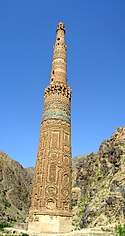Qarlughids
Qarlughid Dynasty | |||||||||||||
|---|---|---|---|---|---|---|---|---|---|---|---|---|---|
| 1238–1266 | |||||||||||||
| Capital | Ghazna, Binban | ||||||||||||
| Common languages | Nāgarī script (written) | ||||||||||||
| Religion | Islam | ||||||||||||
| Government | Monarchy | ||||||||||||
| Malik, Khan | |||||||||||||
• 1238–1249 | Saif al-Din al-Hasan Qarlugh | ||||||||||||
• 1249–1259 | Nasir al-Din Muhammad Qarlugh | ||||||||||||
| History | |||||||||||||
• Established | 1238 | ||||||||||||
• Disestablished | 1266 | ||||||||||||
| Currency | Jital | ||||||||||||
| |||||||||||||
| Today part of |
Countries today
| ||||||||||||
Pre-14th century | |||||||
|---|---|---|---|---|---|---|---|
| Turkic Khaganate 552–744 | |||||||
| Western Turkic | |||||||
| Eastern Turkic | |||||||
| Khazar Khaganate 618–1048 | |||||||
| Xueyantuo 628–646 | |||||||
| Great Bulgaria 632–668 | |||||||
| Danube Bulgaria | |||||||
| Volga Bulgaria | |||||||
| Kangar union 659–750 | |||||||
| Turk Shahi 665–850 | |||||||
| Turgesh Khaganate 699–766 | |||||||
| Uyghur Khaganate 744–840 | |||||||
| Karluk Yabgu State 756–940 | |||||||
| Kara-Khanid Khanate 840–1212 | |||||||
| Western Kara-Khanid | |||||||
| Eastern Kara-Khanid | |||||||
| Ganzhou Uyghur Kingdom 848–1036 | |||||||
| Qocho 856–1335 | |||||||
| Pecheneg Khanates 860–1091 |
Kimek confederation 743–1035 | ||||||
| Cumania 1067–1239 |
Oghuz Yabgu State 750–1055 | ||||||
| Ghaznavid Empire 963–1186 | |||||||
| Seljuk Empire 1037–1194 | |||||||
| Sultanate of Rum | |||||||
| Kerait khanate 11th century–13th century | |||||||
| Khwarazmian Empire 1077–1231 | |||||||
| Naiman Khanate –1204 | |||||||
| Qarlughid Kingdom 1224–1266 | |||||||
| Delhi Sultanate 1206–1526 | |||||||
| Mamluk dynasty | |||||||
| Khalji dynasty | |||||||
| Tughlaq dynasty | |||||||
| Golden Horde | [1][2][3] 1240s–1502 | |||||||
| Mamluk Sultanate (Cairo) 1250–1517 | |||||||
| Bahri dynasty | |||||||
|
Other Turkic dynasties
in Anatolia | |||||||
The Qarlughids, a tribe of Turkic and Hazaras origin, controlled Ghazni and the lands of the Bamyan and the Kurram Valley (Ghazna, Banban, and Kurraman), establishing a Muslim principality and dynasty lasting between 1224 and 1266. The Qarlughids arrived from the north to settle in the regions of Hazarajat together with the armies of Muhammad II of Khwarezm, the Shah of Khwarezm. Throughout most of its existence, the Qarlugh Kingdom functioned as a buffer state between its two powerful neighbors, the Delhi Sultanate to the east and south and the Mongol Empire to the north and west, with [4] The Malik at the throne of Qarlugh would frequently switch allegiances between their two powerful neighbors, and through balanced diplomacy managed to become an important trade intermediary between the Mongols of Central Asia and the lands of the subcontinent. Testimet to Qarlughid prosperity is the significant coinage found from this dynasty.[5]
History
The establishment of the Qarlugh Kingdom was a result of the turbulent power struggles of the 12th and 13th centuries in Greater Khurasan as the Ghurid Empire gave way to the Delhi Sultanate and the Mongols. The lands of Peshwar and the Kurram valley were ruled in rapid succession by Muhammad of Ghor, Taj al-Din Yildiz, Nasir ad-Din Qabacha, Iltutmish, Genghis Khan, Mingburnu, and again Iltutmish, who incorporated them into the Delhi Sultanate. The Sultana of Delhi, Razia al-Din, appointed Saif al-Din al-Hasan Qarlugh as governor of Ghazni, who in 1238 seceded from the Sultanate and asserted the independence of the Qarlugh Kingdom ruling Ghazni, Bamyan, and Kurraman.
The Qarlughids developed rapidly in the wake of the Mongolian invasion and the resulting power vacuum of the preceding decade. They repopulated, rebuilt, and administered the devastated areas, most notably the city of Bamyan that was completely destroyed in the Siege of Bamyan (1221) by Ghenghis Khan, turning the rebuilt city into their stronghold.
See also
References
- ↑ Marshall Cavendish Corporation (2006). Peoples of Western Asia. p. 364.
- ↑ Bosworth, Clifford Edmund (2007). Historic Cities of the Islamic World. p. 280.
- ↑ Borrero, Mauricio (2009). Russia: A Reference Guide from the Renaissance to the Present. p. 162.
- ↑ André Wink (1997). Al-Hind the Making of the Indo-Islamic World: The Slave Kings and the Islamic Conquest : 11Th-13th Centuries. BRILL. ISBN 90-04-10236-1.
- ↑ Royal Asiatic Society of Great Britain and Ireland (1908). Journal of the Royal Asiatic Society of Great Britain and Ireland. Cambridge University Press for the Royal Asiatic Society. Archived from the original on 2010. Retrieved 2016-06-13.
